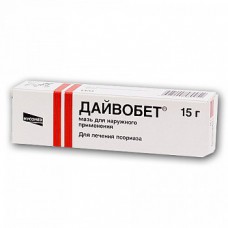Expiration date: 06/2026
Structure and Composition:
Ointment for external application
1 g contains: betamethasone dipropionate 0.643 mg (Equivalent to Betamethasone 0.5 mg)
calcipotriol monohydrate 0.052 mg (Corresponding to 0.05 mg of calcipotriol)
Excipients: liquid paraffin polyoxypropylene-15-stearyl ether alpha-tocopherol White soft paraffin
in tubes of aluminum or PE 15, 30 or 60 grams in paper cartons 1 tube.
Description pharmaceutical form:
Homogeneous ointment from almost white to pale yellow.
Pharmacokinetics:
In applying the drug Daivobet calcipotriol and betamethasone absorption through intact skin is less than 1%. When applying the drug on the psoriatic plaques and under occlusive dressings increases the absorption of topical corticosteroids. Since the skin creates a depot preparation, its elimination from the skin occurs within a few days. Betamethasone is metabolised in the liver and kidneys to form glucuronides and sulfoefirov, excretion is carried out through the intestines and kidneys.
Description of the pharmacological actions:
Calcipotriol - a synthetic analogue of the active metabolite of vitamin D. It is the inhibition of proliferation of keratinocytes and accelerates their morphological differentiation.
Betamethasone - GCS for external use has a local anti-inflammatory, antipruritic, vasoconstrictive and immunosuppressive effect, but the exact mechanisms of the anti-inflammatory actions of topical corticosteroids is unclear until the end. The use of occlusive dressings increases the effect of topical corticosteroids, because it increases their penetration into the dermis.
Testimony:
- Chronic plaque psoriasis vulgaris.
Contraindications:
- hypersensitivity to any component of the drug
- diseases associated with impaired calcium metabolism
- severe renal and hepatic failure
- virus (including cold sores or chicken pox), fungal, bacterial and parasitic infections of the skin, rosacea, acne rosacea, acne vulgaris, perioral dermatitis, cutaneous manifestations of tuberculosis and syphilis, skin atrophy, skin ulcers, increased fragility of the skin vessels, ichthyosis, perianal and genital itch
- erythrodermic psoriasis, guttate, exfoliative, pustular psoriasis.
Application of pregnancy and breastfeeding:
Safety of Daivobet the drug during pregnancy and lactation has not been established, and the drug can be used only when, in the opinion of the physician, therapy with its use is necessary.
Side effect:
The side effects are classified according to frequency of occurrence: the most common -> 1/10 -> 1/100 and <1/10 times -> 1/1000 and <1/100 rare -> 1/10000 and <1/1000 very rarely - <1/10000.
For the skin and skin appendages: often - itching, rash, burning sensation sometimes - pain, irritation, dermatitis, erythema, exacerbation of psoriasis, pigmentation disorders at the site of application of ointment, folliculitis, rare - pustular psoriasis.
Calcipotriol may cause: local skin irritation, itching, burning, sharp pain, dry skin, erythema, rash, dermatitis, eczema and psoriasis worsening.
With long-term topical application of betamethasone (dipropionate) associated with the development of skin atrophy, telangiectasia, striae (especially long-term use), folliculitis, hypertrichosis, perioral dermatitis, allergic contact dermatitis and depigmentation, colloidal skin degeneration, as well as increased risk of generalized pustular psoriasis, reaction hyper- and photosensitivity, including very rare cases of angioedema and facial edema.
systemic reactions
Associated with the use of calcipotriol (very rare) - hypercalcemia or hypercalciuria.
Linked with a topical application of betamethasone (rare but sometimes severe, especially with prolonged use on large surfaces and when using occlusive dressings) - suppression of adrenocortical function, cataracts, infection, increased intraocular pressure.
Drug Interactions:
Unknown.
Dosage and administration:
Outwardly. Adults ointment applied thinly to the affected skin 1 time per day. The maximum daily dose - not more than 15 g, week - no more than 100 g The recommended duration of treatment - 4 weeks. Then Daivobet drug can be re-used under medical supervision. The area of ??application of the drug should not exceed 30% of the body surface.
Overdose:
Symptoms: increased calcium in the blood suppression of pituitary-adrenal system with the development of reversible secondary adrenal insufficiency.
Treatment: removal of preparation and holding of symptomatic therapy. In cases of chronic toxicity of corticosteroids should be withdrawn gradually.
Special instructions:
Do not apply the drug on the skin, mucous membranes and scalp. After applying the ointment, wash your hands.
The risk of hypercalcaemia in compliance with the recommended dosing regimen is minimal. However, when using the drug Daivobet in doses exceeding the recommended maximum weekly dose (100 g), may develop hypercalcemia, quickly passing while reducing the dose or withdrawal.
The product contains a potent GCS Dayvobet, therefore not recommended for concomitant treatment with other glucocorticosteroids.
It is recommended to avoid the use of the drug to large areas of skin that make up more than 30% of the body surface, and under occlusive dressing, applied to the skin folds, as this increases the likelihood of systemic absorption of GCS and the development of systemic adverse reactions.
Side effects, such as suppression of hypothalamic-pituitary-adrenal system with the development of reversible secondary adrenal insufficiency or worsening of diabetes, associated with systemic administration of GCS may occur and long-term use of topical corticosteroids, due to systemic absorption. When a complication of psoriasis secondary infection should be antibiotic therapy, while exacerbating infection - repeal the drug.
Use in children. Experience with Daivobet the drug in children younger than 18 years of absence.
Effects on ability to drive vehicles and management mechanisms. Absent.
During treatment Dayvobetom recommended to limit exposure to natural or artificial sunlight.
Calcipotriol can be used with UV light only if the potential benefits of treatment outweigh the potential risks.
Shelf life:
After opening the package - 12 months.



